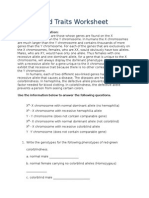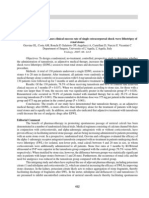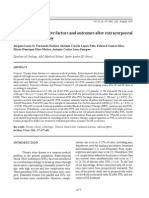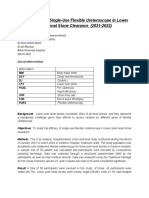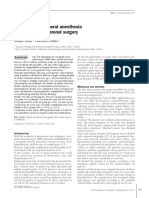Extracorporeal Shock-Wave Lithotripsy Success Rate and Complications: Initial Experience at Sultan Qaboos University Hospital
Extracorporeal Shock-Wave Lithotripsy Success Rate and Complications: Initial Experience at Sultan Qaboos University Hospital
Uploaded by
TheQueensafa90Copyright:
Available Formats
Extracorporeal Shock-Wave Lithotripsy Success Rate and Complications: Initial Experience at Sultan Qaboos University Hospital
Extracorporeal Shock-Wave Lithotripsy Success Rate and Complications: Initial Experience at Sultan Qaboos University Hospital
Uploaded by
TheQueensafa90Original Title
Copyright
Available Formats
Share this document
Did you find this document useful?
Is this content inappropriate?
Copyright:
Available Formats
Extracorporeal Shock-Wave Lithotripsy Success Rate and Complications: Initial Experience at Sultan Qaboos University Hospital
Extracorporeal Shock-Wave Lithotripsy Success Rate and Complications: Initial Experience at Sultan Qaboos University Hospital
Uploaded by
TheQueensafa90Copyright:
Available Formats
Oman Medical Journal (2013) Vol. 28, No. 4:255-259 DOI 10. 5001/omj.2013.
72
Extracorporeal Shock-wave Lithotripsy Success Rate and Complications: Initial Experience at Sultan Qaboos University Hospital
Mohammed S. Al-Marhoon, Omar Shareef, Ismail S. Al-Habsi, Ataalrahman S. Al Balushi, Josephkunju Mathew, and Krishna P. Venkiteswaran
Received: 16 Mar 2013 / Accepted: 05 Jun 2013 OMSB, 2013
Abstract
Objective: To assess the ecacy and safety of extracorporeal shock wave lithotripsy with Modularis Vario Siemens in the management of patients with renal and ureteral stones. Methods: Between 2007 and 2009, 225 outpatients were treated with Siemens Modularis Vario lithotripter at Sultan Qaboos University Hospital. Stone size, location, total number of shockwaves, stone-free rate, complications and adjunctive interventions were investigated. Chi-Square and Logistic Regression analyses were used, with p<0.05 set as the level of signicance. Results: Of the 225 initial consecutive patients who underwent extracorporeal shock wave lithotripsy, 192 (85%) had renal stones and 33 (15%) had ureteric stones. The meanSD stone size was 11.34.5 mm, while the mean age of the patients was 39.912.8 years with 68.5% males. The mean renal stone size was 11.64.7 mm; a mean of 1.3 sessions was required. The mean ureteric stone size was 9.93 mm; and a mean of 1.3 sessions was required. Treatment success (dened as complete clearance of ureteric stones, stone-free or clinically insignicant residual fragments of <4 mm for renal stones) was 74% for renal stones and 88% for ureteric stones. Additional extracorporeal shock wave lithotripsy and ureteroscopy were the most adjunctive procedures used for stone clearance. Complications occurred in 74 patients (38.5%) with renal stones and 13 patients (39.4%) with uretetric stones. The most common complication was loin pain (experienced by 16.7% with renal stones and 21% with ureteric stones). Severe renal colic mandating admission occurred in 2% of patients with renal stones and 6% of patients with ureteric stones. In patients with renal stone, steinstrasse occurred in 3.6% and infection post extracorporeal shock wave lithotripsy in 0.5%. Using Multivariate Logistic Regression analysis, factors found to have signicant eect on complete stone clearance were serum creatinine (p=0.004) and the number of shockwaves (p=0.021). Conclusion: Siemens Modularis Vario lithotripter is a safe and eective tool for treating renal and ureteric stones. Keywords: Extracorporeal shock-wave lithotripsy (ESWL); Kidney; Ureter; Stones.
Introduction
ince its introduction in the 1980s, extracorporeal shock wave lithotripsy (ESWL) has become the standard convenient, noninvasive outpatient procedure used for treatment of renal and proximal ureteric calculi.1 After the introduction of the original electrohydraulic Dornier HM-3 and its high-power delivery, lithotripters have been developed with new sources for generating shock waves, such as electromagnetic and piezoelectric sources. Furthermore, lithotripters have been reduced in size, and now they occupy less space. ESWL focusing and imaging devices have been modied over the years to improve the precise delivery of shock waves to the stone. Despite a decreased power delivery that often implies multiple sessions, second and third-generation machines do not require the use of anesthesia, thus achieving greater patient comfort and tolerance. Few studies have published their experience with the use of the Modularis Vario lithotripter.2 The outcome of ESWL is measured in terms of stone fragmentation and clearance. Failure of ESWL results in unnecessary exposure of renal parenchyma to shock waves and complications, invariably alternative treatments are then needed, incurring additional medical expenses.3 A number of stone characteristics such as fragility, size, location and composition are known to aect outcome.4
Methods
This study aims to assess the safety and ecacy of ESWL with Modularis Vario Siemens for the management of renal and ureteral stone. All patients with renal or ureteric stones, treated at Sultan Qaboos University Hosptial, Oman, using the Modularis Vario lithotripter (Modularis Vario; Siemens, AG Healthcare, Munich, Germany), were recorded retrospectively between May 2007 and November 2009. Complete case-notes and X-rays were evaluated, and follow-up noted in these patients. All patients had complete blood count (CBC), coagulation, Urea and Creatinine, electrolytes (K, Na, Ca), uric acid, coagulation prole (prothrombin time
Mohammed S. Al-Marhoon , Omar Shareef, Ismail S. Al-Habsi, Ataalrahman S. Al Balushi, Josephkunju Mathew, Krishna P. Venkiteswaran
Urology Division, Department of Surgery, Sultan Qaboos University Hospital, Sultanate of Oman. E-mail: msalmarhoon@hotmail.com Oman Medical Specialty Board
Oman Medical Journal (2013) Vol. 28, No. 4:255-259
and concentration), urinalysis, urine culture, ECG for elderly and pregnancy test for childbearing women before ESWL. Exclusion criteria; were uncorrected coagulation and bleeding disorders, pregnancy, gross obesity (>120 kg; due to technical diculty in placing the patient in focus), and obstructed urinary tract distal to the stones. Stone size was determined by the widest diameter for renal and ureteric stones. Stones were categorized according to stone size into 10, 11-20 and >20 mm diameter. Pre-treatment plain abdominal lms of the kidney, ureter, and bladder (KUB), as well as IVU, ultrasonography or non-contrast-unenhanced CT were used for the initial diagnosis, and KUB and ultrasonography two weeks after each session were used to evaluate fragmentation and clearance. For patient preparation before the procedure, patients taking Aspirin or Warfarin were asked to discontinue them 7 days before ESWL, bowel preparation with Bisacodyl (Dulcolax) 10 mg single oral dose and fasting from midnight before ESWL. Double-J stent was inserted prior to ESWL for stones >2 cm. The Modularis Vario is a mobile, fully integrated, new generation lithotripter with an electromagnetic shockwave source, and fully integrated uoroscopic guidance. Energy levels start with E0.1 and gradually increase to a maximum of E8.0 in 38 steps. The average and maximum energy levels, as well as the total energy delivered are automatically shown at the end of each session. Patients were treated while supine; uoroscopy or ultrasound was used to locate the stone. ESWL settings used were as follows: For the Kidney: Number of shockwaves=3000-3500, Energy level (max)=3-4, Starting: 100 shock waves with Level 0.1-1 Afterwards, maximal level: Lower calyx: 3.0 Upper and middle calyx: 3.5 Pelvis: 4.0 with Frequency SW/min=60. For the Ureter: Number of shockwaves = 3500-4500 Energy level (max)=4 (upper ureter), 6 (lower ureter) with Frequency SW/min Upper and middle ureter=90, Lower ureter=120. All treatments were administered on an outpatient basis for a maximum of three sessions. No fragmentation or residual fragments of >4 mm were considered as a failure and patients were oered alternative treatment. All treatments were carried out using intravenous analgesia in the form of Fentanyl IV (1 ug/kg/dose), Midazolam IV (0.05-0.1 mg/kg) and Granisetron IV when needed (10 ug/kg). The patients were monitored during the procedure by checking the vital signs heart rate (HR), respiratory rate (RR), blood pressure (BP) and Oxygen saturation (pulsoxymetry). At the end of treatment, patients were discharged on oral medications including Diclofenac 50 mg TID, Tamsulosin 0.4 mg OD and Ural 1 sachet BD for 2 weeks. The stones were re-assessed initially after 10-14 days, using KUB and ultrasound to assess fragmentation. Repeat treatment was applied immediately after follow-up if there was no or inadequate fragmentation of the stone. Patients were followed up for the outcome of stone clearance for up to 3 months after the rst ESWL session. The number of shock waves, intensity of shock waves, shock-wave energy, stone-free rate, auxiliary procedure rate, re-treatment rate and complication rate were assessed. Treatment success was dened as complete clearance of ureteric stones, while being stone-free or the presence of clinically insignicant residual
fragments of <4 mm were considered as a success for renal stones. The success rate was correlated with the stone size and site. Patient age, sex, site of stone, size of stone, number of shock waves, power, energy delivered, number of sessions, and requirement for auxiliary procedures before or after ESWL were recorded. Chi-Square test was used for statistical evaluation, with the level of signicance set as p<0.05. Univariate and Multivariate Binary Logistic Regression analysis were used to determine factors aecting complete stone clearance.
Results
Of the 225 initial consecutive patients who underwent ESWL, 85% (192/225) had renal stones and 15% (33/225) had ureteric stones. The meanSD (range) stone size in this study was 11.34.5 (5-30) mm; 68.5% (154/225) of the patients were male and 31.5% (71/225) were female. The meanSD (range) age of the patients was 39.912.8 (19-80) years. The commonest clinical presentations in this study were renal colic (57.6%, 51.5%) and renal colic with haematuria (20.4%, 36.4%) for renal and ureteric stones, respectively. There were no comorbidities in 80.7% (155/192) of patients with renal stone and 87.8% (29/33) of patients with ureteric stone, with diabetes and hypertension being the most associated comorbidities, if present. The history of previous renal stones, previous ESWL treatment and previous surgery were 63% (121/192), 45.8% (88/192), 18.8% (36/192) in patients with renal stone; and 15% (5/33), 24% (8/33), 18% (6/33) in patients with ureteric stone, respectively. Before ESWL, 34.9% (67/192) had double-J stent and 12% (23/192) had percutaneous nephrostomy tube in place in patients treated for renal stones compared to 36.4% (12/33) having double-J stent in patients treated for ureteric stones. The right side was the commonest side aected with renal stones 51.6% (99/192) and ureteric stones 63.6% (21/33). Renal stones were associated with hydronephrosis in 20.3% (39/192), whereas ureteric stones in 42.4% (14/33). Stone localization was achieved by uoroscopy in 88% (169/192) of renal stones and 100% (33/33) of ureteric stones. All the patients were treated in the supine position except one patient with ureteric stone was treated in prone. Of the 192 patients with renal stones, 20% (38/192) had pelvic stones, 14% (27/192) had upper calyceal stones, and 22% (42/192) and 44% (84/192) had middle and lower calyceal stones, respectively. The meanSD renal stone size was 11.64.7 mm. A single session was required in 77.6% (149/192) of patients; the mean (range) number of sessions required for clearance of renal stones was 1.3 (1-3). The necessity for three sessions was non-signicantly aected by stone size (p=0.245). However, a higher proportion of stones sized >20 mm (18%) needed three sessions, compared with only 6% of stones sized <10 mm and 2% of stones 11-20 mm in the largest diameter. The meanSD (range) number of shocks required for renal stone was 2884.5672 (700-4000). While the meanSD (range) total energy delivered for renal stones per session was 103.7 32 (14-167) J.
Oman Medical Specialty Board
Oman Medical Journal (2013) Vol. 28, No. 4:255-259
In this series, 33 patients had a single ureteric stone, 94% (31/33) of them were in the upper ureter, 3% (1/33) in the middle third and 3% (1/33) in the lower third. The meanSD ureteric stone size was 9.93 mm. The meanSD (range) number of sessions required for managing ureteric stones was 1.30.6 (1-3). When compared with stone size, stones of <10 mm required 3 sessions in 9% of cases, and 4.5% for stones of 11-20 mm (p=0.248). For all ureteric stones, the meanSD (range) of delivered energy per session was 119.648.8 (14-280) J. The highest required energy was for stones in the lower third of the ureter (155 J) and the lowest energy in middle third stones (90 J). The meanSD number of shocks required per ureteric stone was 3006802.6. Table 1: Adjunctive procedure to clear the stone post ESWL. Adjunctive intervention None Ureteroscopy PCNL Open surgery RIRS Further ESWL Total Kidney No (%) 118 (61.5%) 10 (5.2%) 2 (1%) 2 (1%) 3 (1.6%) 57 (29.7%) 192 (100%) Ureter No (%) 21 (63.6%) 5 (15.2%) 0 0 0 7 (21.2%) 33 (100%)
PCNL: percutaneous nephrolithotomy ; RIRS: retrograde intrarenal surgery
Table 2: Complications observed in the treatment of renal and ureteric stones. Complications No complication Dysuria Urge incontinence Loin pain Suprapubic pain Frequency Gross hematuria UTI Ureteric obstruction Analgesia and hospital admission Obstruction with sepsis Steinstrasse Fever Loin pain and dysuria Loin pain and haematuria Total Kidney No (%) 118 (61.5%) 5 (2.6%) 1(0.5%) 32 (16.7%) 1 (0.5%) 1 (0.5%) 2 (1%) 1 (0.5%) 2 (1%) 4 (2.1%) 1 (0.5%) 7 (3.6%) 3 (1.6%) 9 (4.7%) 5 (2.6%) 192 (100%) Ureter No (%) 20 (60.6%) 1(3%) 0 7 (21.2%) 0 0 2 (6.1%) 0 0 2 (6.1%) 0 0 0 0 1(3%) 33 (100%)
clearance (Table 1). The overall treatment complication rate for this study was 38.7% (87/225). For the renal stones, 74 patients (38.5%) had complications, while for the uretetric stones, 13 patients (39.4%) had complications. The majority of the complications were minor with the most common being loin pain 16.7% and 21% in the treatment of renal and ureteric stones, respectively (Table 2). Severe renal colic mandating a visit to the emergency department and admission for control of pain occurred in 2% (4/192) and 6% (2/33) of patients treated for renal stones and ureteric stones, respectively. Steinstrasse (a complication of extracorporeal shock wave lithotripsy for urinary tract calculi in which stone fragments block the ureter to form a "stone street") occurred in 7 (3.6%) patients treated for renal stones: 3 patients had ureteroscopy, 1 had ESWL and 3 patients were treated conservatively. In this series the infection post ESWL was very low 0.5% and 0% in patients treated for renal and ureteric stones, respectively. Using the Univariate Binary Logistic Regression analysis, factors including: age (p=0.113), serum creatinine [umol/L] (p=0.002), total energy (p=0.504), number of shockwaves (p=0.301), stone size [mm] (p=0.739), stone site [renal pelvis, upper, middle or lower calyx] (p=1.0), number of sessions (p=0.006), sex (p=0.093), presence of double-J stent (p=0.754), stone number (single or mutltiple) (p=0.774), side of the stone (p=0.574), presence of hydronephrosis (p=0.175) and complications (p=0.999), were tested for their eect on stone clearance. However, the factors found to have signicant eect on the complete stone clearance using the Multivariate Binary Logistic Regression analysis were serum creatinine (0.004) and the number of shockwaves 0.021. (Table 3) Table 3: Factors aecting complete stone clearance (Multivariate Logistic Regression). Variable Regression coecient (B) Serum Creatinine -0.021 (umol/L) Total number of -0.545 shockwaves SE Odds Ratio (Exp. B) 0.980 0.580 p value
0.007 0.235
0.004 0.021
Discussion
The use of ESWL for the treatment of renal stones has brought a revolution in the eld of urology. It has not only reduced hospitalization time and morbidity, but is also cost eective. Like any other urological procedure, ESWL is also associated with complications, mainly obstructive and infective. ESWL therapy is noninvasive, anesthesia-free and can be administered in an outpatient setting. Therefore, ESWL remains the rst choice for treating renal and upper and middle ureteric stones. The newer generation of lithotripters use smaller focal zones, allowing higher peak-point pressures.5 The Modularis Vario lithotripter has the advantages of greater comfort for the patient during the procedure, better imaging because of the very high quality of the uoroscopy,
Treatment success (dened as complete clearance of ureteric stones, stone-free or clinically insignicant residual fragments of <4 mm for renal stones) was 74% (142/192) for renal stones and 88% (29/33) for ureteric stones. Additional ESWL and ureteroscopy were the most common adjunctive procedures used for stone
Oman Medical Specialty Board
Oman Medical Journal (2013) Vol. 28, No. 4:255-259
and a great comminution of the stone, achieving a success rate of 74% for renal stones and 88% for ureteric stones in our experience, and decreasing the need for auxiliary manoeuvres. These results are comparable with reported success rates of 40-91%.6 The usual limitations of ESWL studies also aect the present study. We failed to examine fragmentation and stone-free rates based exclusively on stone composition. We did not examine the causes of failure, and most patients seen after treatment were evaluated with a KUB or ultrasound methods with inherent diagnostic limitations. However, the cost associated with the reference standard CT after lithotripsy is a problem and, as such, it is rarely used. Chaussy and Bergsdorf,7 stated that a plain abdominal X-ray (KUB) is accepted as the rst-line diagnostic method for follow-up examination after stone therapy, but tends to overestimates the stone-free rate. Noncontrast spiral CT seems to be the most sensitive radiological tool for detecting residual fragments after stone therapy.7 Auxiliary procedures were minimal in the present series; the auxiliary treatment rate was similar to what has been reported.8 The overall treatment complication rate of this study is 38.7% (87/225), with the majority being minor complications. No major complications were reported in the present study; however, in other studies, acute renal failure has been reported after ESWL.9 Massive retroperitoneal hemorrhage after extracorporeal shock wave lithotripsy (ESWL) leading to patient death has also been reported.10 Besides renal injury,11 ESWL is not completely free from other serious complications, such as gastrointestinal injury in 1.8% of cases, including colonic perforation or duodenal erosions.12 However, there was no association between ESWL and the subsequent long-term risk of hypertension.13 Double-J ( JJ) stent insertion is an important tool in the urologist armamentarium. It has its benets and complications. Insertion of JJs stent for shockwave lithotripsy of renal calculi may be done as a part of therapy (for obstructive pyelonephritis, renal failure, refractory colic, high grade obstruction) or as a prophylactic stenting before ESWL of renal calculi, which is at best controversial. Currently, European urologist guidelines and the American urologist Association guidelines recommend putting a JJ stent before ESWL for renal pelvic stones of 2 cm and above,14 which was implemented in the present study. A study comparing the outcome of ESWL for a renal pelvic stone measuring 2 cm 2 mm with and without JJ stent. With exclusion of patients with renal failure and children, found that Pre ESWL JJ stenting for a 2 cm 2 mm renal stone was not benecial in terms of steinstrasse, fever, stone clearance and number of ESWL sessions. However, ureteric colic was signicantly lower in the stented group. Lower urinary tract symptoms (LUTS) were also signicantly high in the patients having a JJ stent. The cost of the treatment doubled in the stented group, thus JJ stenting does not prove to be a cost eective procedure when compared to the reduction in complications.15 Renal stone is a common problem in Oman because of our geographical location (Oman lies within the stone belt region extending from Indonesia to Egypt), economic and dietary factors, dehydration, exposure to heat and possible genetic factors.16 The
advent of Extra Corporeal Shock Wave Lithotripsy (ESWL) in the 1980s, propelled the treatment of renal stone disease from mainly open surgery into a new era of non invasive procedures. Although the issues of stone density and the type of drinking water were not addressed in the present study, they have been addressed in other studies. Stone types can be estimated by density measurements on computerised tomography (CT). It was reported that it is not reasonable to predict ESWL success with stone densities measured on CT. These densities also cannot predict the number of sessions required during ESWL.17 However, it has been reported that stone density can help to predict the outcome of ESWL, where stones with densities <500 Hounseld units (HU) are highly likely to result in successful ESWL. Conversely, stone densities 800 HU are less likely to do so.18 There are controversies in the literature regarding the need and the duration of antibiotic prophylaxis in patients with extracorporeal shock wave lithotripsy (ESWL), a recent study was performed to evaluate the ecacy of antibiotic prophylaxis in patients with proven sterile urine before they underwent ESWL and found that the incidence of urinary tract infections after ESWL is extremely low, as also shown by our present study, and prophylaxis antibiotics do not seem to be necessary.19 Previous investigations that attempted to nd a correlation between the hardness of water (the molar sum of calcium and magnesium found in water, mg/L) and urolithiasis have yielded to contradictory results. Similarly, there is no consensus on the eects of mineral content of fresh water such as calcium and bicarbonate on the incidence of urinary calculus.20 In a recent study,21 no correlation was found between the incidence of urinary calculus and the amount of calcium, bicarbonate, or the total hardness of drinking water. In contrast, the incidence of urinary calculus was inversely related with drinking water magnesium content. In the present study Tamsulosin was routinely used postESWL. The ecacy of the tamsulosin (oral 0.4 mg/d for 1 month) as an adjuvant therapy to extracorporeal shock wave lithotripsy (ESWL) for the expulsion of ureteral and renal stones was studied in 186 patients (77 ureteral and 109 renal stones).22 It was found that adjuvant treatment with tamsulosin, in addition to standard treatment with steroids and analgesics, signicantly improved the stone clearance rate. In addition, Tamsulosin treatment was also associated with a signicantly lower interval to the elimination of stone fragments, a signicantly lower re-hospitalization rate, and a signicantly lower proportion of patients with acute renal colic.
Conclusion
The Siemens Modularis Vario lithotripter is a safe and eective machine for treating renal and ureteric stones. Our initial data from this large, single-centre series shows an acceptable success rate of 74% (142/192) for renal stones and 88% (29/33) 88% for ureteric stones. Therefore, the Modularis Vario is an appropriate and eective tool for treating urinary calculi, especially up to 20 mm in diameter. In the present study, the factors found to have a signicant eect on the complete stone clearance were serum creatinine and number of shockwaves.
Oman Medical Specialty Board
Oman Medical Journal (2013) Vol. 28, No. 4:255-259
Acknowledgements
The authors reported no conict of interest and no funding was received for this work.
References
1. Chaussy C, Brendel W, Schmiedt E. Extracorporeally induced destruction of kidney stones by shock waves. Lancet 1980 Dec;2(8207):1265-1268. 2. Mohamed E. Hassouna SOWSAE-A. Clinical experience with shock-wave lithotripsy using the Siemens Modularis Vario lithotripter. Arab Journal of Urology 2011;9:101-105 . 3. Nomikos MS, Sowter SJ, Tolley DA. Outcomes using a fourth-generation lithotripter: a new benchmark for comparison? BJU. Int. 2007;100:1356-1360. 4. Bon D, Dore B, Irani J, Marroncle M, Aubert J. Radiographic prognostic criteria for extracorporeal shock-wave lithotripsy: a study of 485 patients. Urology 1996 Oct;48(4):556-560, discussion 560-561. 5. Augustin H. Prediction of stone-free rate after ESWL. Eur Urol 2007 Aug;52(2):318-320. 6. Jamshaid A, Ather MH, Hussain G, Khawaja KB. Single center, single operator comparative study of the eectiveness of electrohydraulic and electromagnetic lithotripters in the management of 10- to 20-mm single upper urinary tract calculi. Urology 2008 Nov;72(5):991-995. 7. Christian C, Thorsten B. The preferred treatment for upper tract stones is extracorporeal shock wave lithotripsy (ESWL) or ureteroscopic: pro ESWL. Urology 2009 Aug;74(2):259-262. 8. Lalak NJ, Moussa SA, Smith G, Tolley DA. The Dornier Compact Delta lithotripter: the rst 150 ureteral calculi. J Endourol 2002 Nov;16(9):645-648. 9. Schmitt R. BJSA. Akutes Nierenversagen nach extra-korporaler Stowellenlithotripsie. Nephrologe 2011;6:439-442 . 10. Inoue H, Kamphausen T, Bajanowski T, Trbner K. Massive retroperitoneal haemorrhage after extracorporeal shock wave lithotripsy (ESWL). Int J Legal Med 2011 Jan;125(1):75-79. 11. Bergsdorf T, Thro S, Chaussy Ch. The isolated perfused kidney: an in vitro test system for evaluation of renal tissue damage induced by high-energy shockwaves sources. J Endourol 2005 Sep;19(7):883-888.
12. Maker V, Layke J. Gastrointestinal injury secondary to extracorporeal shock wave lithotripsy: a review of the literature since its inception. J Am Coll Surg 2004 Jan;198(1):128-135. 13. Krambeck AE, Rule AD, Li X, Bergstralh EJ, Gettman MT, Lieske JC. Shock wave lithotripsy is not predictive of hypertension among community stone formers at long-term followup. J Urol 2011 Jan;185(1):164-169. 14. European Association of urology. [Home page of European Association of Urology] [Online]. [Cited December 2011] Available from URL: http://www. uroweb.org/. 2011. 11-12-2011. 15. Mohayuddin N, Malik HA, Hussain M, Tipu SA, Shehzad A, Hashmi A, et al. The outcome of extracorporeal shockwave lithotripsy for renal pelvic stone with and without JJ stenta comparative study. J Pak Med Assoc 2009 Mar;59(3):143-146. 16. Hussain M. LMABSANSAHR. Urolithiasis in Sindh: a single centre experience with a review of 10,000 cases. J Nephrol Urol Transplant 1998;1:1013. 17. Goren MR. Buoctmiploh. Can we predict the success of shockwave lithotripsy by stone density measured with computerised tomography. Eur Urol Suppl 2006;5:186 . 18. Sanjeev Pathaka. Radiological determination of stone density and skin-to-stone distance-Can it predict the success of extracorporeal shock wave lithotripsy? Br J Med Surg Urol 2009;2:180-184 . 19. Basiri AS, Shakhssalim N, Khoshdel AR, Pakmanesh H, Radfar MH. Drinking water composition and incidence of urinary calculus: introducing a new index. Iran J Kidney Dis 2011 Jan;5(1):15-20. 20. Caudarella R, Rizzoli E, Bua A, Bottura A, Stefoni S. Comparative study of the inuence of 3 types of mineral water in patients with idiopathic calcium lithiasis. J Urol 1998 Mar;159(3):658-663. 21. Basiri A, Shakhssalim N, Khoshdel AR, Pakmanesh H, Radfar MH. Drinking water composition and incidence of urinary calculus: introducing a new index. Iran J Kidney Dis 2011 Jan;5(1):15-20. 22. Georgiev MI, Ormanov DI, Vassilev VD, Dimitrov PD, Mladenov VD, Popov EP, et al. Ecacy of tamsulosin oral controlled absorption system after extracorporeal shock wave lithotripsy to treat urolithiasis. Urology 2011 Nov;78(5):1023-1026.
Oman Medical Specialty Board
You might also like
- Sex Linked Traits Worksheet 2015Document5 pagesSex Linked Traits Worksheet 2015Jeffrey Ells67% (3)
- MRCS A Paper 1 SBAs Applied Basic Sci 2eDocument17 pagesMRCS A Paper 1 SBAs Applied Basic Sci 2eaeages100% (1)
- Case Based AnesDocument251 pagesCase Based AnesRDNo ratings yet
- Failed Spinal Anesthesia PDFDocument2 pagesFailed Spinal Anesthesia PDFShamim100% (1)
- Extracorporeal Shockwave Lithotripsy For Ureteral StonesDocument5 pagesExtracorporeal Shockwave Lithotripsy For Ureteral StonesTatik HandayaniNo ratings yet
- Should Ureteroscopy Be Considered As The First Choice For Proximal Ureter Stones of Children?Document6 pagesShould Ureteroscopy Be Considered As The First Choice For Proximal Ureter Stones of Children?TheQueensafa90No ratings yet
- Eswl Jurnal BrazilDocument5 pagesEswl Jurnal BrazilTheQueensafa90No ratings yet
- Bilateral Same-Session Ureterorenoscopy: A Feasible Approach To Treat Pan-Urinary Stone DiseaseDocument7 pagesBilateral Same-Session Ureterorenoscopy: A Feasible Approach To Treat Pan-Urinary Stone DiseaseAinu RamadhaniNo ratings yet
- Revisiting The Predictive Factors For Intra-Op-erative Complications of Rigid UreterosDocument8 pagesRevisiting The Predictive Factors For Intra-Op-erative Complications of Rigid UreterosTatik HandayaniNo ratings yet
- Krav Chick 2005Document4 pagesKrav Chick 2005victorcborgesNo ratings yet
- 11ijcem0008 4501Document7 pages11ijcem0008 4501FurqanHidayatullahNo ratings yet
- A Novel Technique For Treatment of Distal Ureteral Calculi: Early ResultsDocument4 pagesA Novel Technique For Treatment of Distal Ureteral Calculi: Early ResultsTheQueensafa90No ratings yet
- Recurrence StoneDocument7 pagesRecurrence Stonerafo18No ratings yet
- V34n4a05 PDFDocument10 pagesV34n4a05 PDFvictorcborgesNo ratings yet
- Ather 128 132 PDFDocument5 pagesAther 128 132 PDFLea Bali Ulina SinurayaNo ratings yet
- ESWL in Pokhara NepalDocument4 pagesESWL in Pokhara NepalyoginikunjNo ratings yet
- Extracorporeal Shock Wave LithotripsyDocument6 pagesExtracorporeal Shock Wave LithotripsyTirbuAndreiNo ratings yet
- Emergency Extracorporeal Shockwave Lithotripsy For Acute Renal Colic Caused by Upper Urinary-Tract StonesDocument4 pagesEmergency Extracorporeal Shockwave Lithotripsy For Acute Renal Colic Caused by Upper Urinary-Tract StonesvictorcborgesNo ratings yet
- Comparison of Percutaneous Nephrolithotomy and Retrograde Intrarenal Surgery in Treating 20-40 MM Renal StonesDocument5 pagesComparison of Percutaneous Nephrolithotomy and Retrograde Intrarenal Surgery in Treating 20-40 MM Renal StonesputraNo ratings yet
- Ureteric ComplicationsDocument7 pagesUreteric ComplicationstnsourceNo ratings yet
- Extracorporeal Shockwave Lithotripsy Research WorkDocument6 pagesExtracorporeal Shockwave Lithotripsy Research WorkSabra Memon100% (1)
- Treatment of Upper Urinary Tract Stones With Extracorporeal Shock Wave Lithotripsy (ESWL) Sonolith VisionDocument5 pagesTreatment of Upper Urinary Tract Stones With Extracorporeal Shock Wave Lithotripsy (ESWL) Sonolith VisionTatik HandayaniNo ratings yet
- Miniature Semi-Rigid Ureteroscopy With Holmium-YttDocument7 pagesMiniature Semi-Rigid Ureteroscopy With Holmium-YttMohamed SwilamNo ratings yet
- Jurnal Batu Saluran KemihDocument3 pagesJurnal Batu Saluran KemihharbianNo ratings yet
- Lucio 477 482Document6 pagesLucio 477 482fkorkesNo ratings yet
- Ureteroscopy Outcomes, Complications and Management of Perforations in Impacted Ureter StonesDocument5 pagesUreteroscopy Outcomes, Complications and Management of Perforations in Impacted Ureter StonesLaila KurniaNo ratings yet
- A Prospective Randomized Study Comparing Shock Wave Lithotripsy and Semirigid Ureteroscopy For The Management of Proximal Ureteral CalculiDocument6 pagesA Prospective Randomized Study Comparing Shock Wave Lithotripsy and Semirigid Ureteroscopy For The Management of Proximal Ureteral CalculiMahendra AdityaNo ratings yet
- Assessment of Stricture Formation With The Ureteral Access SheathDocument5 pagesAssessment of Stricture Formation With The Ureteral Access SheathVinícius Dall'AquaNo ratings yet
- Comparitive Study of Fifty Cases of Open Pyelolithotomy and Ureterolithotomy With or Without Double J Stent InsertionDocument4 pagesComparitive Study of Fifty Cases of Open Pyelolithotomy and Ureterolithotomy With or Without Double J Stent InsertionSuril VithalaniNo ratings yet
- Surgical ResearchDocument6 pagesSurgical ResearchScivision PublishersNo ratings yet
- The - Efficacy - of - Single - Use - Flexible Ureteroscope in Lower - Pole - RenalDocument7 pagesThe - Efficacy - of - Single - Use - Flexible Ureteroscope in Lower - Pole - Renalaazeem337333No ratings yet
- DownloadDocument6 pagesDownloadAndradaLavricNo ratings yet
- Multi-Tract Percutaneous NephrolithotomyDocument5 pagesMulti-Tract Percutaneous Nephrolithotomythanhtung1120002022No ratings yet
- Nephro-Urology Monthly Nephro-Urology Monthly Nephro-Urology MonthlyDocument3 pagesNephro-Urology Monthly Nephro-Urology Monthly Nephro-Urology MonthlyTheQueensafa90No ratings yet
- dw20081126964 1mini16Document6 pagesdw20081126964 1mini16T RonaskyNo ratings yet
- Palliative Management of Malignant Rectosigmoidal Obstruction. Colostomy vs. Endoscopic Stenting. A Randomized Prospective TrialDocument4 pagesPalliative Management of Malignant Rectosigmoidal Obstruction. Colostomy vs. Endoscopic Stenting. A Randomized Prospective TrialMadokaDeigoNo ratings yet
- Horshoe KidneDocument5 pagesHorshoe KidneteguhdjufriNo ratings yet
- Cjim 7 001 PDFDocument6 pagesCjim 7 001 PDFMay Renny RajaNo ratings yet
- Surgical Management of Urolithiasis: Charles T. Durkee, MDT, Anthony BalcomDocument13 pagesSurgical Management of Urolithiasis: Charles T. Durkee, MDT, Anthony BalcomRajarshi KumarNo ratings yet
- Clinical Study: Retrograde Intrarenal Surgery Versus Percutaneous Lithotripsy To Treat Renal Stones 2-3 CM in DiameterDocument5 pagesClinical Study: Retrograde Intrarenal Surgery Versus Percutaneous Lithotripsy To Treat Renal Stones 2-3 CM in DiameterAslesa Wangpathi PagehgiriNo ratings yet
- PCNL For StonesDocument43 pagesPCNL For StonesAbdul KhaliqueNo ratings yet
- BahanDocument6 pagesBahanrikarikaNo ratings yet
- Management of Feline Ureteral Obstructions: An Interventionalist's ApproachDocument6 pagesManagement of Feline Ureteral Obstructions: An Interventionalist's ApproachvetgaNo ratings yet
- Ureteroscopy Under Spinal Versus General Anaesthesia: Morbidity and Stone ClearanceDocument4 pagesUreteroscopy Under Spinal Versus General Anaesthesia: Morbidity and Stone ClearanceAndradaLavricNo ratings yet
- Stones Final 09 October 2020Document23 pagesStones Final 09 October 2020Eduardo AñonuevoNo ratings yet
- Role of Sexual Intercourse After Shockwave Lithotripsy For Distal Ureteral Stones: A Randomized Controlled TrialDocument5 pagesRole of Sexual Intercourse After Shockwave Lithotripsy For Distal Ureteral Stones: A Randomized Controlled TrialAnindya Laksmi LarasatiNo ratings yet
- Pone 0065060Document5 pagesPone 0065060TheQueensafa90No ratings yet
- Icu 60 21Document8 pagesIcu 60 21manueljna2318No ratings yet
- Tips and Tricks in Laparoscopic Ureterolithotomy For Large Ureteric Stones About 8 CasesDocument4 pagesTips and Tricks in Laparoscopic Ureterolithotomy For Large Ureteric Stones About 8 CasesInternational Journal of Innovative Science and Research TechnologyNo ratings yet
- Extracorporeal Shockwave Lithotripsy - StatPearls - NCBI BookshelfDocument21 pagesExtracorporeal Shockwave Lithotripsy - StatPearls - NCBI BookshelfMoutaz DahshanNo ratings yet
- ObatDocument4 pagesObatBudi satriaNo ratings yet
- Comparison of ESWL and Ureteroscopic Holmium LaserDocument5 pagesComparison of ESWL and Ureteroscopic Holmium LaserShania Dyah Kurnia DewiNo ratings yet
- A Huge Left Staghorn Kidney, A Case Report of Inevitable Open Surgery: A Case ReportDocument3 pagesA Huge Left Staghorn Kidney, A Case Report of Inevitable Open Surgery: A Case Reportmudasir61No ratings yet
- Asymptomatic Lower Calyceal Renal Calculi - To Treat or Not To TreatDocument2 pagesAsymptomatic Lower Calyceal Renal Calculi - To Treat or Not To TreatJuzteen Bianca Mae AndinoNo ratings yet
- 1 s2.0 S2666168323001957Document9 pages1 s2.0 S2666168323001957nirvaniacNo ratings yet
- Corresponding Member of National Academy of Science Of, Academician of RussianDocument4 pagesCorresponding Member of National Academy of Science Of, Academician of RussianRavilNo ratings yet
- Combined Laparoscopic Pyelolithotomy and Endoscopic Pyelolithotripsy For Staghorn Calculi: Long-Term Follow-Up Results From A Case SeriesDocument6 pagesCombined Laparoscopic Pyelolithotomy and Endoscopic Pyelolithotripsy For Staghorn Calculi: Long-Term Follow-Up Results From A Case SeriesantonNo ratings yet
- Ain Shams Published PapersDocument14 pagesAin Shams Published PapersHUSAMNo ratings yet
- Endourology and Stone Diseases: Original ArticlesDocument5 pagesEndourology and Stone Diseases: Original ArticlesTatik HandayaniNo ratings yet
- 4- Research Article - Anil KumarDocument6 pages4- Research Article - Anil KumarphotojournalistpkNo ratings yet
- 9342-Article Text-51901-1-10-20210318Document5 pages9342-Article Text-51901-1-10-20210318Vicente, Mary Angeline E.No ratings yet
- D ASOf-nask 1Document7 pagesD ASOf-nask 1Academecian groupNo ratings yet
- Karami 022 029Document8 pagesKarami 022 029TheQueensafa90No ratings yet
- Therapeutic Endoscopic UltrasoundFrom EverandTherapeutic Endoscopic UltrasoundEvangelos KalaitzakisNo ratings yet
- 1471 5945 10 10Document3 pages1471 5945 10 10TheQueensafa90No ratings yet
- Jurnal 2Document5 pagesJurnal 2TheQueensafa90No ratings yet
- A Novel Technique For Treatment of Distal Ureteral Calculi: Early ResultsDocument4 pagesA Novel Technique For Treatment of Distal Ureteral Calculi: Early ResultsTheQueensafa90No ratings yet
- Jurnal 1Document4 pagesJurnal 1TheQueensafa90No ratings yet
- Nephro-Urology Monthly Nephro-Urology Monthly Nephro-Urology MonthlyDocument3 pagesNephro-Urology Monthly Nephro-Urology Monthly Nephro-Urology MonthlyTheQueensafa90No ratings yet
- Pone 0065060Document5 pagesPone 0065060TheQueensafa90No ratings yet
- Karami 022 029Document8 pagesKarami 022 029TheQueensafa90No ratings yet
- Crim Urology2013-932529Document3 pagesCrim Urology2013-932529TheQueensafa90No ratings yet
- Recurrent Renal Colic: A Case StudyDocument2 pagesRecurrent Renal Colic: A Case StudyTheQueensafa90No ratings yet
- Knowledge, Beliefs and Perception of Youth Toward Acne VulgarisDocument4 pagesKnowledge, Beliefs and Perception of Youth Toward Acne VulgarisTheQueensafa90No ratings yet
- 2013 Article 589Document8 pages2013 Article 589TheQueensafa90No ratings yet
- The in Uence of Genetics and Environmental Factors in The Pathogenesis of Acne: A Twin Study of Acne in WomenDocument6 pagesThe in Uence of Genetics and Environmental Factors in The Pathogenesis of Acne: A Twin Study of Acne in WomenTheQueensafa90No ratings yet
- 2008 05 CPG Fresh Warm Whole BloodDocument12 pages2008 05 CPG Fresh Warm Whole BloodTheQueensafa90No ratings yet
- Galactocele Is A Benign Breast Tumor of The Mammary Gland Which Is More Prevalent During Pregnancy or LactationDocument4 pagesGalactocele Is A Benign Breast Tumor of The Mammary Gland Which Is More Prevalent During Pregnancy or LactationTheQueensafa90No ratings yet
- Skin Training 2Document81 pagesSkin Training 2TheQueensafa90100% (3)
- Ans KeyDocument36 pagesAns KeyMarius Clifford BilledoNo ratings yet
- Chromosomal DisordersDocument30 pagesChromosomal DisordersamaratariqueNo ratings yet
- Mhdpow PDFDocument95 pagesMhdpow PDFGana PathiNo ratings yet
- Fuller AlbrightDocument4 pagesFuller AlbrightTenri AshariNo ratings yet
- Competition Ratios 2017 ST3 PDFDocument8 pagesCompetition Ratios 2017 ST3 PDFAshish BamaniaNo ratings yet
- Professional Advancement & Role and Scope of NursingDocument15 pagesProfessional Advancement & Role and Scope of Nursinganusarannya100% (6)
- Vaginal Exam Learning GuideDocument2 pagesVaginal Exam Learning GuideAprilian Ayu SitaNo ratings yet
- Midwife in AustraliaDocument13 pagesMidwife in AustraliaNinne GerdhaNo ratings yet
- 2013 EAUN Guideline Milan 2013-Lr DEF PDFDocument98 pages2013 EAUN Guideline Milan 2013-Lr DEF PDFdr5y3dNo ratings yet
- Disorders of Pigmentation and MelanocytesDocument4 pagesDisorders of Pigmentation and MelanocytesPipoy AmyNo ratings yet
- Minor Tooth Correction With The "Essix System" - A Case ReportDocument2 pagesMinor Tooth Correction With The "Essix System" - A Case Reportdent in dentistNo ratings yet
- Dr. Gerald Crabtree - Our Fragile Intellect, Part IDocument3 pagesDr. Gerald Crabtree - Our Fragile Intellect, Part ILeakSourceInfoNo ratings yet
- Clinical Diagnosis in Plastic SurgeryDocument166 pagesClinical Diagnosis in Plastic SurgeryFrancoDaniloRocaLandaveri100% (6)
- Resume Abigail RodriguezDocument2 pagesResume Abigail Rodriguezapi-520026903No ratings yet
- 382 EHS Hospitals ListDocument39 pages382 EHS Hospitals ListRams RamsNo ratings yet
- The Issue of Kinked Tail in Syrian HamsterDocument10 pagesThe Issue of Kinked Tail in Syrian Hamsterapi-247769641No ratings yet
- The Beacon EpaperDocument26 pagesThe Beacon EpaperCatawba SecurityNo ratings yet
- PRC E-Tool Maternal Reviewed by Dr. BallenaDocument4 pagesPRC E-Tool Maternal Reviewed by Dr. BallenaMichael John F. NatividadNo ratings yet
- Edt 321 Resume For Tiffany Schulzetenberg 1Document4 pagesEdt 321 Resume For Tiffany Schulzetenberg 1api-294648032No ratings yet
- Harun Alrasyid, NS, S.Kep: Career ResumeDocument2 pagesHarun Alrasyid, NS, S.Kep: Career ResumeharunNo ratings yet
- Breast Milk Collection and Storage in TheDocument8 pagesBreast Milk Collection and Storage in TheNanda PurnamaNo ratings yet
- Human BodyDocument100 pagesHuman Bodyapi-26829072No ratings yet
- Standard For Hospital Providing Neonatal Intensibe Care and High Dependency CareDocument22 pagesStandard For Hospital Providing Neonatal Intensibe Care and High Dependency CareDouglas MenjivarNo ratings yet
- Jamaicas Health SystemsDocument33 pagesJamaicas Health Systemsgdudex118811No ratings yet
- 2019 1125 ResumeDocument2 pages2019 1125 ResumeStephanie Ann KiziukiewiczNo ratings yet
